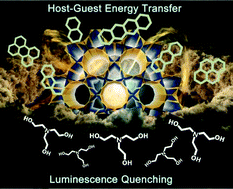Luminescent metal–organic frameworks encapsulating polycyclic aromatic hydrocarbons for energy transfer†
Abstract
We synthesized a novel MOF with an sqc1575 topology as an ideal host matrix that exhibits luminescence energy transfer with polycyclic aromatic hydrocarbons (PAHs). What's more, the PAHs@MOF composites display an interesting quenching behavior in the presence of the electron donor triethanolamine (TEOA). We report for the first time that the well-defined porosity of a luminescent MOF enables it to serve as a host matrix for encapsulating chromophoric PAH molecules to modulate luminescence properties, and further exploit its reductive quenching properties by using a photocatalytic sacrificial electron donor.



 Please wait while we load your content...
Please wait while we load your content...